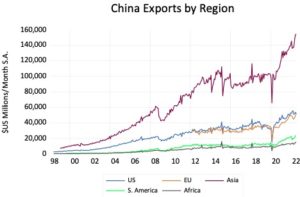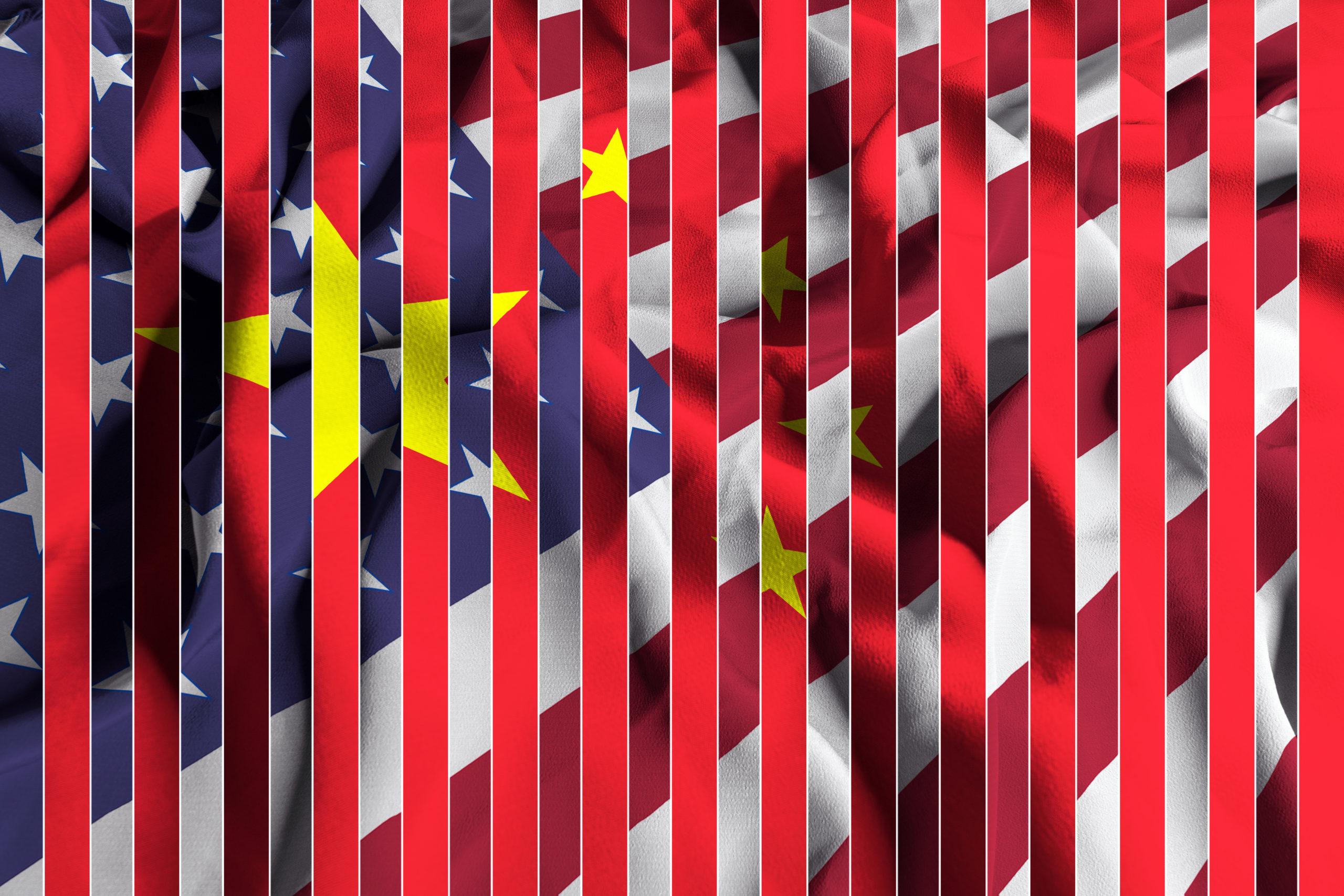An infusion of new and previously forbidden ideas—but can they cohere?
Five Myths About China

And why they will get us killed.
The following is a transcript of remarks originally given in Miami at the National Conservatism Conference in September 2022.
The digital age was a byproduct of America’s Cold War victory. In 1973, Soviet surface-to-air missiles destroyed 100 American planes flown by Israel. Soviet anti-tank weapons were the world’s best. America was depleted by Vietnam. The oil price quadrupled, to America’s detriment and Russia’s advantage. The smart money bet on a Russian victory in the Cold War.
But in 1982, American and Israeli avionics destroyed nearly 100 Russian airframes in a day’s fighting in the Beqaa Valley. In between those two milestones, we invented every technology of the digital age, all with basic research funded by the Pentagon. The federal development budget was nearly 1% of GDP, vs. 0.3% today. When Reagan announced the Strategic Defense Initiative in 1983, Russia concluded that it couldn’t compete with American technology, and Communism fell. That was high-tech sorcery. Today we have sorcerer’s apprentices playing war games with Taiwan.

50 years later, the so-called Fourth Industrial Revolution presents challenges as grave as those of the Cold War, but we are far less ready to meet them. China’s 2,000 surface-to-ship missiles are a game-changer, like the Russian SAMs of 1973, or the dive bombers and torpedo planes that eliminated the battleship as a frontline platform at the start of World War II. China has the jump on us in building hypersonic weapons—that term does not appear in Trump strategist Elbridge Colby’s book, Strategy of Denial—for which there presently is no defense. Bridge’s “Strategy of Denial” offers no evaluation of the revolutionary impact of anti-ship missiles, which means that it is not even wrong; it is simply irrelevant to the crisis we now face.
CSIS held a recent war game on a U.S.-China war over Taiwan. In the core scenario, the U.S. loses two carriers and 700 planes while China loses 150 ships. But the game contains assumptions that Chinese analysts ridicule, for example, the presence of a Marine Littoral Regiment on Taiwan to fight Chinese invaders. Unless they go as tourists, Marines will never make it to Taiwan. An attempt to move U.S. troops to the island in combat-relevant strength would trigger preemption by the mainland.
So would a so-called porcupine weapons buildup in Taiwan. That is the “Sleepwalkers” scenario of which Admiral James Stavridis and others have warned, by reference to the outbreak of the First World War: If one side mobilizes, the other has no choice but to preempt, and war becomes inevitable. It is fanciful to expect Beijing to sit on its hands while we raise the cost of reunification.
Do the math: What’s the probability of a Chinese missile hitting a moving U.S. ship? What’s the proportion of missiles we can shoot down? Multiply any numbers you pick by 2,000 and the outcome is catastrophic. It took the sinking of the Bismarck, the Italian fleet at Taranto, the Repulse and Prince of Wales, and the U.S. fleet at Pearl Harbor to convince the world’s navies that cheap torpedo planes and dive bombers made the battleship obsolete. Let’s hope we don’t have to learn the same lesson in the same hard way.
For a generation Taiwan has pretended to arm itself and the mainland has pretended to be deterred. Taiwan’s young people don’t want to be ruled by Beijing party bosses, but they don’t want to do more than four months’ military service. Taiwan can’t find pilots for the F-16s it buys from us. Meanwhile two million Taiwanese work on the mainland, where Taiwan has invested $200 billion. We can kick that can down the road while we rebuild our strength. Or we can fight a war now that we probably will lose.
A Dangerous Mythology
Right now we are laboring under five myths about China that could get a lot of us killed.
Myth #1: America is making China rich, and can weaken it by reducing imports, investment, and so forth.
China’s exports to the U.S. fell to 2% of its GDP in 2021 from 9% in 2005.

Nonetheless the absolute level of Chinese exports to the U.S. has jumped by 50% since the Trump tariffs went into effect in August 2019. Six trillion dollars of stimulus bought Chinese rather than American goods, because our creaky supply chains can’t meet a surge in demand.

China has a trillion-dollar trade surplus, which means it exports capital. We have a $1.4 trillion trade deficit, which means we import capital. In fact, we have imported a net $18 trillion of capital in the past 30 years to cover our deficits. Stopping Americans from investing in China is a waste of time.
Myth #2: China depends on stolen American technology.
China didn’t steal U.S. know-how to build a hypersonic missile that can circle the globe and hit its target, because we don’t know how to do that. China buys and steals plenty of technology from the West. But China leads in key high-tech fields, notably including broadband communications.
China now graduates seven times as many engineers and scientists as we do each year. According to the U.S. News 2021 rankings, China has 21 of the world’s 50 best engineering programs. China recruits its best graduates into its military industry. Ours work for Big Tech companies that won’t work for the Pentagon. By some measures, the quality as well as the quantity of China’s scientific output surpasses ours.
We poured $6 trillion down the drain in forever wars and let our industries atrophy. We did this to ourselves, and it’s time that we faced up to our own failures instead of looking for someone to blame.
Myth #3: China faces demographic collapse.
The whole industrial world faces demographic decline. Japan, South Korea, and Taiwan are worse off than China. With only one child per female, Taiwan’s working-age population will fall from 16 million to 5 million in the course of the century. Taiwan’s status will be resolved by self-shrinkage. South Korea is disappearing even faster, which makes reunification with the North likely by mid-century.

There are two possible remedies for a declining work force: import young workers, or export capital to where young workers live. China’s Belt and Road Initiative plans to assimilate more than a billion people from the Global South into China’s economic sphere.
Sino-forming of the Global South is in full swing. China’s exports to the Global South nearly doubled in the past two years and are twice its exports to the U.S.

For example, Huawei is building Indonesia’s broadband system and training 10,000 officials in cybersecurity. China is assimilating Southeast Asia into its economy through high-speed rail. BRI has many failures, but what should frighten us is China’s success. We have 750 foreign bases. China has exactly one. We imagine that China wants to spend trillions to project military power around the world, because we think China is as stupid as we are. We want to make the world safe for democracy. China wants to control the economic life of billions.
Myth #4: China wants to take over Taiwan because it is led by an expansionist Marxist-Leninist party that hates and fears democracy.
China is Marxist in the same way that the Mafia is Catholic. They take such things seriously, but ruthless pragmatism guides their actions. The territorial integrity of China is a raison d’état of any Chinese regime, Communist or otherwise. China is not a nation-state but a polyglot empire that has broken apart countless times in its history, almost always as a result of foreign intervention. A breakaway province is an existential threat to the integrity of this or any other Chinese state. Some of our hawks think we should promote the disintegration of China, and Chinese suspicions about our intentions cannot be exaggerated. Have no illusions: China will go to war over Taiwan.
By the same token, China will accept an indefinite continuation of Taiwan’s status quo to avoid the risk and high cost of war. At best, a U.S.-Chinese war would trigger a global economic collapse and threaten the CPC’s mandate in China.
Myth #5: We can deter China by shifting military forces to Asia and adding to conventional capabilities.
The America of 1973 couldn’t beat the Soviet Union. But America turned itself into a different country by 1982. To meet the Chinese challenge, we must reinvent ourselves again. Unless we think in trillions, not billions, we are wasting our time.
We have five cats to bell:
- We need to fund federal R&D at the Reagan level, that is, an additional 1% of GDP, or roughly $2 trillion over ten years;
- We need a radical revision of tax and regulatory policy to favor capital-intensive manufacturing;
- We need selective subsidies for mission-critical industries;
- We need to shift in educational priorities toward engineering and hard science; and
- We need to shift defense priorities away from legacy systems toward innovation, including space-based missile defense, directed-energy weapons, cyber war, and drone swarms.
I can’t be specific about our path back to technological leadership. In 1973, no-one knew that CMOS chip manufacturing would put lookdown radar into F-15’s by 1978. We unleashed American creativity and entrepreneurship, and reinvented both military and civilian technology. Innovation is our great advantage over China. We require the courage to rely on it.
The American Mind presents a range of perspectives. Views are writers’ own and do not necessarily represent those of The Claremont Institute.
The American Mind is a publication of the Claremont Institute, a non-profit 501(c)(3) organization, dedicated to restoring the principles of the American Founding to their rightful, preeminent authority in our national life. Interested in supporting our work? Gifts to the Claremont Institute are tax-deductible.
Now is the time to go on the offensive.
Conservatives must re-learn the fundamentals of the family.
Functional life in a normal society doesn’t just happen by accident.
We can’t beat China without facing up to the capture of the ruling class.
Conservatives must stop consenting to play the domesticated opposition.






